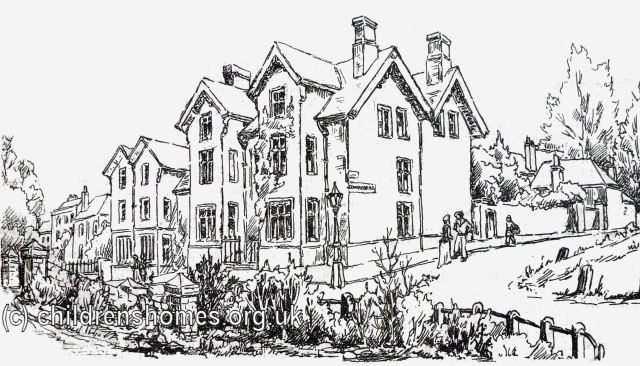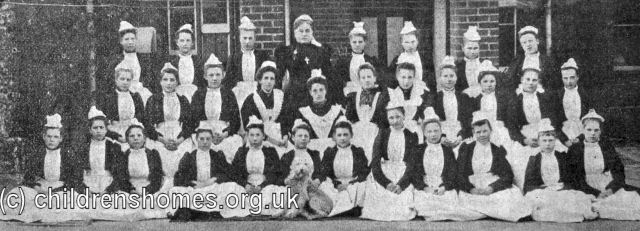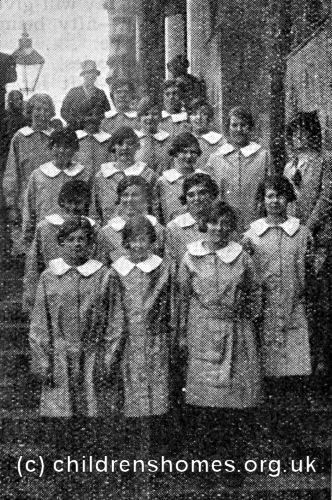Connaught House Home for Girls, Winchester, Hampshire
In 1865, a house at 63 Romsey Road, Winchester, became home to the Carlisle Memorial Refuge for Female Convicts, also known as Carlisle House. It was established by an enlightened former prison governor, Sir Walton Crofton, who had been in charge of prisons in Ireland. It received, six months' prior to their liberation, female convicts whose conduct had proved satisfactory in prison.
1n 1882, the premises were taken over by the Connaught House Home for Girls, also known as the Diocesan Home for Training Girls for Service or Emigration. The object of the home was 'to rescue friendless girls from evil surroundings before they have fallen into degradation.' The house could accommodate up to 27 girls aged 12 to 17 who were trained for work as general or domestic servants, either at home or through emigration to the colonies. As well as being taught the duties of servants and laundry maids, the girls received elementary education, religious instruction, and classes in needlework. After first having been affiliated to the Waifs and Strays Society, the home was transferred to the Society in 1886. The matron at this date was Miss Atkinson.

Connaught House Home for Girls, Winchester, c.1886. © Peter Higginbotham

Connaught House Home for Girls, Winchester, c.1899. © Peter Higginbotham

Connaught House Home for Girls, Winchester, c.1899. © Peter Higginbotham
Part of the property was used a boarding-house for ladies which allowed the girls to gain real-life experience as housemaids. The girls cleaned their guests' rooms, made their beds, cooked food, and waited on tables at meal times. Here is an extract from an 1899 account of a visit to the home:
When the girls first come to the Home they are told off, each to their own special employments. Some to do the bedrooms in the training side of the house, where they have to become expert before they are allowed to wait on the boarders. Others are sent to take their share in the laundry work. Others are despatched to the kitchen. In each department there is a special matron, and over all again another matron. These soon discover for what particular work a girl shows particular aptitude; and then, after a time, she is usually kept in that department, so that she may become a really good laundress, housemaid, or cook.
The day I went over the Home I saw many of the girls at their several duties, all looking clean and neat in their print frocks and white caps. I also saw the dining-room, drawing-room, and. one or two of the bedrooms on the boarding-house side. They all looked bright and cheerful, many of them having pretty, old-fashioned bow-windows, which always add so much to the appearance of a room, On the ground floor is a little chapel, where morning and evening prayers are read daily, and where the Rev. J. A. Ladbroke takes a class weekly for the religious instruction of the girls. On Sundays the whole household goes to St Thomas's Church, though from time to time the Holy Eucharist is celebrated in the Chapel. When the time of training is over, the Committee help the girls to get places, or if they wish they assist them to emigrate. All are provided with outfits when they leave.

Connaught House Home for Girls, Winchester, c.1930. © Peter Higginbotham
The home closed in 1930. The property now houses a local NHS facility.
Former Connaught House Home for Girls, Winchester.
Records
Note: many repositories impose a closure period of up to 100 years for records identifying individuals. Before travelling a long distance, always check that the records you want to consult will be available.
- Index of the Society's first 30,000 children's case files ordered by surname.
- Index of the Society's first 30,000 children's case files ordered by date of birth.
- The Children's Society Records and Archive Centre is at Unit 25, Springfield House, 5 Tyssen Street, London E8 2LZ (email: archives@childrenssociety.org.uk). Files for children admitted to its homes after September 1926 were microfilmed in the 1980s and the originals destroyed. Some post-1926 files had already been damaged or destroyed during a flood. The Society's Post-Adoption and Care Service provides access to records, information, advice, birth record counselling, tracing and intermediary service for people who were in care or adopted through the Society.
- The Society has produced detailed catalogues of its records relating to disabled children, and of records relating to the Children's Union (a fundraising body mostly supported from the contributions of children).
Bibliography
- Bowder, Bill Children First: a photo-history of England's children in need (1980, Mowbray)
- Church of England Waifs and Strays' Society [Rudolfe, Edward de Montjoie] The First Forty Years: a chronicle of the Church of England Waifs and Strays' Society 1881-1920 (1922, Church of England Waifs and Strays' Society / S.P.C.K.)
- Higginbotham, Peter Children's Homes: A History of Institutional Care for Britain's Young (2017, Pen & Sword)
- Morris, Lester The Violets Are Mine: Tales of an Unwanted Orphan (2011, Xlibris Corporation) — memoir of a boy growing up in several of the Society's homes (Princes Risborough, Ashdon, Hunstanton, Leicester) in the 1940s and 50s.
- Rudolf, Mildred de Montjoie Everybody's Children: the story of the Church of England Children's Society 1921-1948 (1950, OUP)
- Stroud, John Thirteen Penny Stamps: the story of the Church of England Children's Society (Waifs and Strays) from 1881 to the 1970s (1971, Hodder and Stoughton)
Links
- Hidden Lives Revealed — the story of the children who were in the care of The Children's Society in late Victorian and early 20th Century Britain.
- The Children's Society
Except where indicated, this page () © Peter Higginbotham. Contents may not be reproduced without permission.


